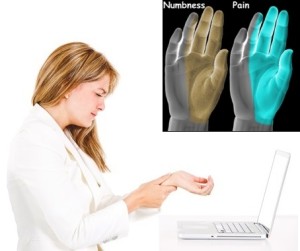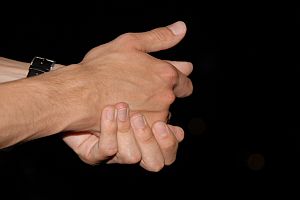Hands
7 Chiropractic Treatments for Carpal Tunnel Syndrome, Without Medication or Surgery
 You’ve probably felt thumb, hand or wrist pain before after doing a lot of gripping work, computer work or engaging in lots of texting on the phone, but is this pain carpal tunnel syndrome? Or leading to it?
You’ve probably felt thumb, hand or wrist pain before after doing a lot of gripping work, computer work or engaging in lots of texting on the phone, but is this pain carpal tunnel syndrome? Or leading to it?
My clients come in with various hand pains, which they experience as aching, pins and needles, burning, cramping, weakness, or numbness especially at night and when you flex your wrist. Sometimes the wrist and hands just feel swollen.
Carpal Tunnel Syndrome, or CTS, is a common health concern which is experienced around the wrist area. And it is important that you know if you are getting CTS because the most common treatment for CTS can be severe -it involves either medication or surgery. This can include heavy medication or serious surgery. If you have symptoms that sound like CTS, the good news is, even if it has gotten to the point of excruciating, it is possible to avoid surgery and medication and receive effective, less intrusive treatments.
Chiropractors effectively manage conditions like CTS using natural, painless, less intrusive methods. A Chiropractor will be able to get to know your body and how to alleviate pain and solve a CTS problem as soon as it occurs.
Now, by understanding your CTS symptoms you can appreciate what your body is going through and be in the best position to work with your chiropractor to alleviate the pain and symptoms. Let’s dive in…
What Is Carpal Tunnel Syndrome (CTS)?
The carpal bones are small bones in the wrist area that form a tunnel that surrounds the nerve leading to the hand, called the median nerve. When Carpal Tunnel Syndrome (CTS) occurs, the tendons and joints become swollen which pinches the median nerve inside. CTS is usually initiated by forceful or repetitive movements that occur at the wrist as well as with the entire arm and shoulder complex. These movements result in swelling around your tendons, which leads to and is experienced as pinching of the median nerve. CTS can also occur due to a compression of the nerves along their tracks down and up from your neck. If a forceful or repetitive stress activity effects your neck, the symptoms may or not be felt at the neck but may be transmitted all the way down into your hands and is experienced as CTS-like symptoms.
What Are the Specific Symptoms Associated with CTS?
If you are experiencing CTS symptoms, you may be feeling painful tingling in your hand or arm area. There may also be a lack of muscle strength in your arm, or you may lose control of your hand, with pain shooting from your hand up to your shoulder.
Who Experiences CTS?
CTS is a common workplace, as well as computer user’s, hazard. Repetitive motions can cause CTS to occur due to repetitive computer and office tasks. This means that many workers are at risk of developing CTS symptoms. Store and factory workers who may frequently receive micro-traumas to their hands and wrists are especially at risk.
CTS injury is often due to the awkward positioning; forceful and repetitive movements, repetitive wrist flexion and extension activities, using vibratory tools, and doing lots of gripping.
How to Avoid Medicine and Surgery with Chiropractic Treatment
If you wish to avoid opting for medicine or surgery to alleviate Carpal Tunnel Syndrome, there are certain steps that you can take. This is particularly helpful if you have a preference against medication or you have intolerance to Ibuprofen.
Importantly, CTS should be diagnosed early on. If the diagnosis is neglected for too long, the condition can become severe. In this case, surgery may be an obligatory requirement. However, the good news is that if CTS is caught in its early stages, chiropractic treatment can be a very effective solution.
How Effective Can Chiropractic Treatment Be for CTS?
Chiropractic treatment for CTS is a drug-free method, which alleviates your pain and can offer long-term relief. When studied against other conventional, non-surgical medical treatment, chiropractic treatment for CTS was found to be effective.
How Does Chiropractic Treatment for CTS Work?
CTS is caused by the median nerve in the wrist becoming trapped. These nerves connect to the spinal cord through the opening in the bones in your lower neck. Your CTS symptoms often occur when these lower neck bones are misplaced or move to a different position. Chiropractic treatment can gently reset the bones to their correct position which can help alleviate CTS symptoms.
7 Chiropractic Methods to Alleviate the Pain Caused by CTS
Chiropractic treatment can occasionally involve a combination of various chiropractic methods. The following seven methods are the key chiropractic treatments that can effectively help your CTS symptoms.
- Chiropractic Manipulation Therapy: Manipulation Therapy involves manipulation of the wrist, elbow and upper spine area. This is where your joint’s soft tissue can undergo manipulation to affect the surrounding area. Recent studies have concluded that manual therapy intervention, such as soft tissue mobilization (also called STM), helps to improve the signs and symptoms of CTS. STM can be particularly effective in improving nerve conduction latencies, which positively impacts wrist strength and motion. No other profession effectively delivers this type of treatment.
- Intake of Nutritional Supplements: Supplements to a balanced diet can promote long-term healing. Nutritional supplements such as B6 can be particularly effective and has been promoted as a long-standing supplement for the treatment of CTS.
- Bracing: This treatment involves bracing, which is a technique that has had extensive success. Bracing limits extension and flexion in your hand. Compression on the median nerve can encourage recovery and ease swelling in the tendons.
- Ice and Rest: Ice is an effective treatment to relieve the swelling around the nerve and is also deliverer often at the wrist when indicated. Rest helps to put an end to the causative factors that are resulting in the nerve compression.
- Ultrasound and Electrical Stimulation Modalities: Ultrasound therapy has been shown to assist carpal tunnel syndrome. Huisstede et al (2010). Acupuncture has been shown to decrease carpal tunnel pain. Sim et al (2011), Kumnerddee & Kaewtong (2010), Yang et al (2011). Using electrical stimulation has been shown to ease the pain associated with carpal tunnel syndrome. Kara et al (2010).
- Daily Exercises: Specifically tailored exercises can effectively promote recovery and the easing of symptoms when carried out daily. Exercises, given to you by your chiropractor, help to work the wrist and hand, which are designed to encourage recovery.
- Reassessment of the Work Place Efficiency: Reviewing the ergonomics of the way you work can significantly help to minimize stress, which will promote recovery and prevent further injury.
Do you have any questions? Our team is happy to help you and answer any questions or concerns you may have.
Dr. Nicole Muschett, a Bethlehem, Pennsylvania Chiropractor, is here to help overcome CTS. She offers a no-obligation free consultation, to get to know you and the problems you are experiencing. Just contact us today.
The Secret Weapons that Can Keep You Flexible and Young
 Everyone develops scar tissue over time. This is the body’s normal reaction to injury—no matter how slight.
Everyone develops scar tissue over time. This is the body’s normal reaction to injury—no matter how slight.
But scar tissue can keep you stiff and increasingly inflexible. Because of it many people can’t do the activities they used to enjoy like play tennis or garden.
Even simple actions that most people wouldn’t regard as injury-producing can lead to a buildup of scar tissue. Repetitive motions like typing, for example, can cause micro-trauma to the soft tissue (often referred to as an overuse injury), leading to carpal tunnel syndrome. As part of the repair process, scar tissue is created.
Scar tissue is important for you to understand because it tends to interfere with the smooth movement of muscle and may eventually affect your range of motion or how well you move your hands, turn your head to see the car in your blind spot or bend your body to stretch your muscles effectively. The effects of scar tissue doesn’t have to progress to the point where it’s uncomfortable to you if it’s nipped in the bud at the right time.
If you have ever felt a tightness or inability to move a joint in a fluid manner, you likely have a buildup of scar tissue. Our soft tissues (including tendons and ligaments) are made of collagen, which is a substance that looks like strands of rope wound together into a net-like formation called fascia. When an injury occurs, it causes frays, kinks and bends in the collagen strands of the fascia, which create the scar tissue. Ideally, scar tissue is replaced by normal tissue as it heals, but this does not always happen.
Adhesions are small bits of scar tissue that bind the tissues around them, leading to stiffness and a reduction in strength and range of motion. Nerves often become trapped in these adhesions, creating “trigger points” from which pain can radiate. Painful movements lead to less activity, and less activity leads to a further reduced range of motion. Because scar tissue has less circulation and is less flexible and elastic than normal muscle tissue, muscles become shorter and weaker. It is important to remove these scar tissue adhesions in order to reduce pain and restore strength and the proper range of motion.
The secret weapons to relieve built up scar tissue so you stay flexible and young:
Hands-on therapies such as the Active Release Technique (ART), Graston Technique and Myofascial Release are used by some chiropractors as a way of breaking up scar tissue to release trapped nerves and restore greater range of motion.
Hands-on therapies are the only way to get true relief of the body’s scar tissues. The Graston Technique uses stainless steel instruments to break up the fascia, whereas ART and Myofascial Release employ a direct hands-on approach to remove adhesions and break up scar tissue.
Many chiropractors incorporate one or both of the above therapies into their practice to help increase their patient’s strength and range of movement, as well as helping their chiropractic adjustments to last longer.
You can become more flexible and pain-free, even if you’ve already started feeling the effects of scar tissue build up. And the best thing about getting hands-on therapy by a chiropractor is, the more fluid and free of scar tissue your muscles and joints are, the less likely tense muscles will pull the spine or other joints back out of alignment. We offer hands-on, pain-free, chiropractic care that is the most effective method of eliminating scar tissue and other stiffness in your muscles and joints. Receive a complimentary “Pain Relief and Flexibility” consultation by contacting us today.